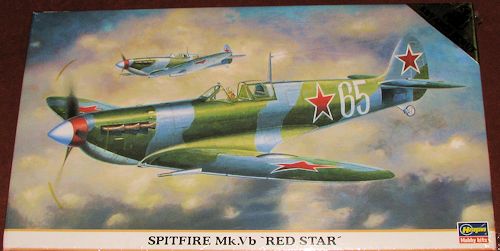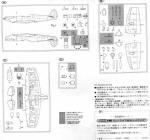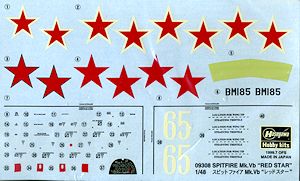
Hasegawa 1/48 Spitfire Vb 'Red Star'
| KIT #: | 09308 |
| PRICE: | $20.00 SRP |
| DECALS: | Two options |
| REVIEWER: | Scott Van Aken |
| NOTES: | Limited Reissue (1999) |

| HISTORY |
The Spitfire VB became the main production version of the Mark Vs. Along with the new Merlin 45 series the B wing was fitted as standard. As production progressed changes were incorporated, some of which became standard on all later Spitfires. Production started with several Mk IBs which were converted to Mk VBs by Supermarine. Starting in early 1941 the round section exhaust stacks were changed to a "fishtail" type, marginally increasing exhaust thrust. Some late production VBs and VCs were fitted with six shorter exhaust stacks per side, similar to those of Spitfire IXs and Seafire IIIs; this was originally stipulated as applying specifically to VB(trop)s. After some initial problems with the original Mk I size oil coolers, a bigger oil cooler was fitted under the port wing; this could be recognised by a deeper housing with a circular entry. From mid-1941 alloy covered ailerons became a universal fitting.
A constant flow of modifications were made as production progressed. A "blown" cockpit hood, manufactured by Malcolm, was introduced in an effort to further increase the pilot's head-room and visibility. Many mid to late production VBs - and all VCs - used the modified, improved windscreen assembly with the integral bullet resistant centre panel and flat side screens introduced with the Mk III. Because the rear frame of this windscreen was taller than that of the earlier model the cockpit hoods were not interchangeable and could be distinguished by the wider rear framing on the hood used with the late-style windscreen.
Different propeller types were fitted, according to where the Spitfire V was built: Supermarine and Westland manufactured VBs and VCs used 10 ft 9 in (3.28 m) diameter, 3 bladed de Havilland constant speed units, with narrow metal blades, while Castle Bromwich manufactured VBs and VCs were fitted with a wide bladed Rotol constant speed propeller of either 10 ft 9 in (3.28 m) diameter, with metal blades, or (on late production Spitfires) 10 ft 3 in (3.12 m) diameter, with broader, "Jablo" (compressed wood) blades. The Rotol spinners were longer and more pointed than the de Havilland leading to a 3.5 in (8.9 cm) increase in overall length. The Rotol propellers allowed a modest speed increase over 20,000 ft (6,100 m) and an increase in the service ceiling. A large number of Spitfire VBs were fitted with "gun heater intensifier" systems on the exhaust stacks. These piped additional heated air into the gun bays. There was a short tubular intake on the front of the first stack and a narrow pipe led into the engine cowling from the rear exhaust.
The VB series were the first Spitfires able to carry a range of specially designed "slipper" drop tanks which were fitted underneath the wing centre-section. Small hooks were fitted, just forward of the inboard flaps: when the tank was released these hooks caught the trailing edge of the tank, swinging it clear of the fuselage.
With the advent of the superb Focke Wulf Fw 190 in August 1941 the Spitfire was for the first time truly outclassed, hastening the development of the "interim" Mk IX. In an effort to counter this threat, especially at lower altitudes, the VB was the first production version of the Spitfire to use "clipped" wingtips as an option, reducing the wingspan to 32 ft 2 in (9.8 m).The clipped wings increased the roll rate and airspeed at lower altitudes. Several different versions of the Merlin 45/50 family were used, including the Merlin 45M which had a smaller "cropped" supercharger impeller and boost increased to +18 lb. This engine produced 1,585 hp (1,182 kW) at 2,750 ft (838 m), increasing the L.F VB's maximum rate of climb to 4720 ft/min (21.6 m/s) at 2,000 ft (610 m).
The Mk VB(trop) (or type 352) could be identified by the large Vokes air filter fitted under the nose; the reduced speed of the air to the supercharger had a detrimental effect on the performance of the aircraft, reducing the top speed by 8 mph (13 km/h) and the climb rate by 600 ft/min (3.04 m/s), but the decreased performance was considered acceptable. This variant was also fitted with a larger oil tank and desert survival gear behind the pilot's seat. A new "desert" camouflage scheme was applied. Many VB(trop)s were modified by 103 MU (Maintenance Unit-RAF depots in which factory fresh aircraft were brought up to service standards before being delivered to squadrons) at Aboukir, Egypt by replacing the Vokes filter with locally manufactured "Aboukir" filters, which were lighter and more streamlined. Two designs of these filters can be identified in photos: one had a bulky, squared off filter housing while the other was more streamlined. These aircraft were usually fitted with the wide blade Rotol propeller and clipped wings.
| THE KIT |
 Sometimes
there are kits that sit on store shelves for an age. So it is with
this particular Hasegawa boxing. Just to show you how much pricier
kits have gotten, this one retailed for $20 in 1999/2000 and is
probably near twice that nowadays.
Sometimes
there are kits that sit on store shelves for an age. So it is with
this particular Hasegawa boxing. Just to show you how much pricier
kits have gotten, this one retailed for $20 in 1999/2000 and is
probably near twice that nowadays.  ame
to me. Clipped wing tips are on the sprues but this boxing is
supposed to use the standard length wing tips.
ame
to me. Clipped wing tips are on the sprues but this boxing is
supposed to use the standard length wing tips. Instructions are standard Hasegawa with Gunze paint references. Two markings options are provided, neither one of which is fancy. One is the box art plane with the white 65 and white surround stars. The other only has black surround stars with a sky fuselage band. Standard camo scheme. The decals are nicely done and have all the stencils you'll need. It also has an instrument panel decal.
| CONCLUSIONS |
| REFERENCES |
http://en.wikipedia.org/wiki/Spitfire_V#Mk_V
2014
My thanks to me for picking this one up.
If you would like your product reviewed fairly and fairly quickly, please contact the editor or see other details in the Note to Contributors.
Back to the Previews Index Page